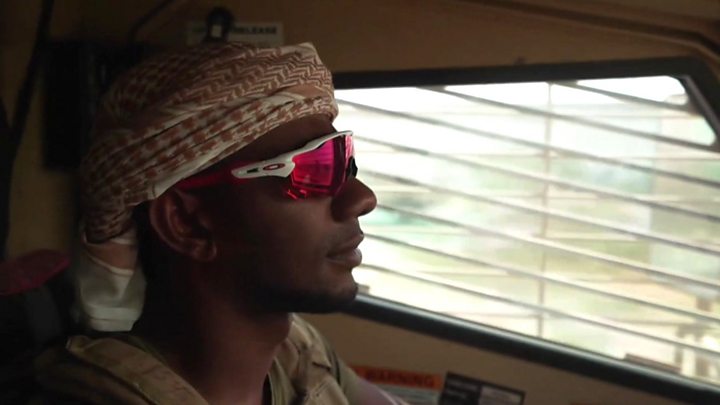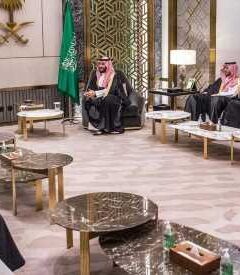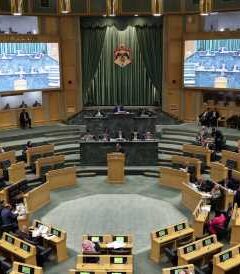Home » Middle East »
Shaky truce in key Yemeni port of Hudaydah
“If there’s peace, we’ll protect it. And if not, we’re ready for orders to attack,” declares Mohammed Salman of the Yemeni army’s Third Brigade.
An occasional crackle of gunfire pierces an eerie silence at the Red Sea Mills, a battle-scarred granary on the eastern edge of the strategic port city of Hudaydah.
This vital warehouse still stores a sea of wheat sacks in a country on the cusp of famine.
Last November, fighters from the rebel Houthi movement were pushed from this complex by the army, which is backed by a Saudi-led multinational coalition and an array of local militias.
The Houthis’ positions now lie just 1.5km (0.9 miles) away, beyond a wrecked metal fence reinforced by a jumble of tyres.
“Look what the Houthis are doing,” says a soldier, pointing towards a plume of thick black smoke billowing on the horizon. “They’re burning tyres to try to provoke us.”
This is where the front lines were drawn in the sand when a surprise ceasefire was agreed in talks in faraway Sweden in mid-December.
It is a critical part of a broader UN-brokered deal to avert an all-out assault by the army on Hudaydah, which provides a gateway for almost all of the aid that Yemen needs desperately.
We travelled with Saudi and Emirati forces to this crucial corner of Yemen’s war.
Military helicopters and heavily armoured vehicles took us along the west coast, skirting the Red Sea, to see the impact of this rare truce in Hudaydah and its wider province.
It is fragile, and fraught with risk. The Red Sea Mills granary marked the furthest point we were told we could safely reach.
It now stands idle, a sad stark symbol of a merciless war that shoots through every part of life in this region’s poorest nation.
Precious grain is strewn across its desolate grounds, where hulking metal machines, peppered by bullet holes, lie rusting.
“We’re hopeful we can get access to the Red Sea Mills that have been cut off by fighting since September,” the head of the UN’s World Food Programme in Yemen, Stephen Anderson, tells me in an email.
There is said to be enough food here to feed almost 4 million Yemenis for a month in a country where three quarters of the population depends on humanitarian assistance.
After we left, a mortar believed to have been fired by Houthis struck this facility, sparking a fire which destroyed vital wheat stocks in two of its 10 silos.
“It’s devastating for us, just devastating,” laments Lise Grande, the UN’s resident co-ordinator in Yemen, in an interview with the BBC in the rebel-held capital, Sanaa, 140km (87 miles) to the east. “It’s not clear we can replace it.”
Yemeni commanders also accuse the Houthis of sneaking in, under cover of darkness, to plant landmines and booby traps in this area.
Sudanese militiamen, recruited by the Saudi-led coalition, are currently carefully combing the fields with metal detectors.
Coalition forces accuse the Houthis of hundreds of ceasefire violations.
The Houthis accuse the army and coalition of massing forces on the southern edges of Hudaydah city, and along the west coast, readying for a new assault if this ceasefire collapses.
“I haven’t seen any additions to our troops,” says Colonel Saeed Salman, who commands the United Arab Emirates task force on this critical front.
The colonel nevertheless underlines the coalition is “always ready” for battle, if political leaders take that decision.
Last year Saudi Arabia and the UAE – the main players in the coalition, which is armed by Western countries – came under stinging criticism for air strikes the UN says have caused the greatest number of civilian casualties.
The coalition’s intermittent blockades and punitive polices are also said to have exacerbated Yemen’s slide towards famine.
Photographs from inside Hudaydah obtained from a resident of the city show Houthis fortifying their positions with metal containers and concrete barriers, in anticipation of any enemy advances.
The two countries insist the Houthis – who are aligned to their arch-rival, Iran – are to blame for the humanitarian disaster.
Col Saeed emphasises that the coalition fully backs the UN’s peace efforts. “Everyone knows diplomacy is part of war,” he remarks.
But he warns that any Houthi attacks on the coalition’s key supply lines along the Red Sea, or on the land route connecting the south to Hudaydah, would be regarded as “red lines”.
Under the terms of the deal reached in Stockholm last December, Houthi forces were expected to have pulled out of Hudaydah’s main port and two other nearby ports, as well as Hudaydah city by now.
That was to trigger a mutual redeployment of rival forces from this coveted area.
The UN is now doubling down on efforts to implement the arrival of 75 UN observers mandated by a Security Council resolution passed two weeks ago.
The International Crisis Group, a Brussels-based think tank that is closely monitoring the situation in Hudaydah, notes that whatever its weaknesses, the ceasefire initiative is still the best shot at peace in many years.
Neither side has tried to gain ground since the truce came into play. But neither side trusts the other.
However imperfect the truce, it has had some impact.
Stephen Anderson of the WFP says it has afforded the agency and its partners some “breathing space” to distribute food in areas of southern Hudaydah that were impossible to reach during the fighting.
At a field hospital run by the Emirates Red Crescent in Durayhimi, just south of Hodeida, Yemeni doctors say they are treating considerably fewer patients.
“Before there were 75, sometimes 120, injured and dead arriving here every day,” says Iyad Mahfouz Nasser, the hospital’s deputy manager. “But now there are about 25 or 35.”
An ambulance screeches to a halt beside us. Twenty-year-old Hayat was sitting at home when a sniper’s bullet skimmed her head, leaving a deep red gash. It could so easily have taken her life.
“All my children were scared and crying,” exclaims her father Ali, visibly shaken. “The war came right into our house.”
“Snipers, landmines, mortars, gunshots,” says Mr Nasser, listing the kinds of casualties who still keep coming in. “What use is this ceasefire?”
Everywhere we went on this side of the front line, we heard the same refrain in Arabic. From angry doctors to defiant soldiers and malnourished mothers, they all say the same: “There is no ceasefire.”
At another hospital further south, in the town of Khawkhah, Dr Saleh is trying to attend to every patient in turn on a day when every bed is his ward is full.
On one cot, a young Yemeni soldier is writhing in pain. His face is peppered with shrapnel. A stretcher races past us carrying a moaning teenager, his hand blown off by a land mine.
“I fear if the ceasefire stops, it will be even more catastrophic,” Dr Saleh says. “Some people won’t even be able to reach the hospitals.”
And in every clinic and every hospital, the youngest in Yemen are a startling symbol of a nation’s plight.
At a hospital in the government-controlled southern city of Aden, beds in two rooms are taken by children whose families fled Hudaydah.
“This is the worst malnutrition I’ve seen in seven months,” says Dr Ramzi Elaiwah, shaking his head as he looks at five-month-old Adwa.
This tiny baby’s condition is so shocking that it is hard not to look away. Her name means “light”, but Adwa can hardly see. She lost one eye to infection, the empty socket bulging in a skeletal face.
Some 1.8 million Yemeni children are acutely malnourished, hovering between life and death.
“The politicians need to understand the effects of the war,” Dr Elaiwah remarks.
“I think they do,” he says, adding with a weary smile. “But we should remind them.”
Source: Read Full Article



